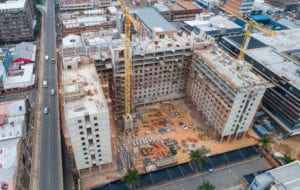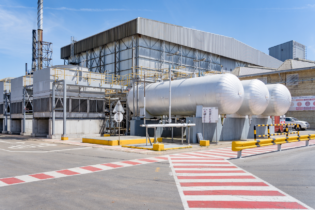Buildings are crucial to the well-being of people, and designers and architects have the responsibility to ensure that sustainable solutions are placed at the forefront of any potential new project.
This is the view of SAIA president, Dr Luyanda Mpahlwa, who was a keynote speaker in the inaugural AfriSam SAIA Sustainable Design Awards webinar entitled “Towards Liveable Sustainability – Rethinking Architecture in a Post Covid-19 World”. The webinar, co-hosted by IZUBA INafrica Architect Dr Philippa Tumubweinee, is continuing to drive the message of sustainable architecture and design as a means of solving a number of critical issues in South Africa. The webinar highlighted challenges that architects and designers will be faced with in the future, given the new norm of remote working brought about by Covid-19, with Mpahlwa sharing insights on how challenges can be addressed while maintaining the vision of sustainability. “The reality is that buildings and construction are undoubtedly contributors to carbon emissions, and we have a responsibility to reduce these emissions by using innovative methods that often mean reverting back to basics,” he says. “Buildings are made to serve people, and we must ensure that they are at the centre of all that we do. We should not forget about the most basic design principles. “These include the orientation of a building to maximise thermal performance, the use of non-toxic materials and paint, and taking advantage of as much natural light and ventilation as possible. Once we have these in place, we can explore additional elements to make the building, in its totality, a green building.” The industry, he says, needs to adapt to the needs of society, pointing to the need to consider repurposing vacant buildings, especially given from the shift to working from home.While he does not see Covid-19 as the death of the office, he does see it as an opportunity to talk about how this space can be best utilised going forward.
While many financial districts – as the major drivers in the formation of a CBD – have relocated to form secondary CBD’s such as Sandton, a number of potential buildings have been vacated in the country’s CBD’s. Mpahlwa suggests that in a bid to alleviate South Africa’s challenge in providing affordable housing, many of these buildings can be converted into economical residential apartments. This, he says, will not only move some citizens closer to their places of work, but will create a culture of city living similar to numerous cities in Europe and even in Africa’s northern countries. Further, it will reduce the need to construct new residences on the outskirts of the cities, and decrease the amount of air pollution as citizens would not need to commute as far. “The AfriSam-SAIA Sustainable Design Award is not only about recognising sustainable architectural feats or sustainable practises relating to a single solution, but address a number of urgent societal issues relating to economic, environmental and social impact. Ultimately, they promote the need for a new way of thinking,” he concludes. The next AfriSam-SAIA Sustainable Design Award webinar will take place in August. For those wanting to enter the 2020 AfriSam-SAIA Sustainable Design, the submission date has been extended to 31 July 2020. For more information on the awards, visit www.sustainabledesign.co.za







